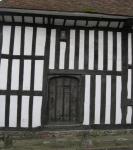Emily Rebecca Morris (1865 - 1936)


Two of the very fine old houses in Petham indicating the wealth that some of its inhabitants once had.
JOHN MORRIS and ANN HYDE
Shortly before the deaths of his parents in 1831 and 1834, John MORRIS married Ann HYDE at Petham by banns the 24th of December 1828. Both bride and groom were single residents of the parish and signed the register. John and Ann had four children, of whom the first born was the John MORRIS who was the father of Emily Rebecca. Interestingly, they named their second child William Angel MORRIS, thus continuing the given name of both Ann’s brother and father who were named Angel HYDE. The unusual name Angel is from the west country, well known in Cornwall from the 16th century according to E.G. Withycombe, the acknowledged expert in these matters. Ann herself was the daughter of Angel HYDE and Rebecca FORRESTER who married by licence the 26th of December 1782 at St Nicholas Guildford in Surrey. Rebecca was of the parish, while Angel is referred to as ‘of Maidstone’ at the time of marriage. They had at least six children, three sons and three daughters. First-born Angel, baptised the 28th of January 1785 at Godalming in Surrey, was followed by Rebecca, baptised the 13th of August 1786, also at Godalming, and then by David (born 1789 at Canterbury) and William (baptised the 22nd of August 1790 at Canterbury St Margaret); daughters Ann and Hannah were baptised, respectively, the 16th of August 1795 and the 15th of April 1797 at Eastry.
There may have been other births in the intervening years. John MORRIS and Ann HYDE were the 2 x maternal great grandparents of George Aldis who, in the course of his research, came across a descendant of Ann’s brother David, thus making that person a 4th cousin. Angel HYDE and Rebecca seemed to have remained in Kent for the rest of their lives, he being buried, aged 76, the 13th of March 1831 at Abbots Place and she, aged 79, the 26th of August 1838 at Canterbury St Alphege.

A painting of the interior of St Alphege Church w here Rebecca Hyde is buried. St Alphege is now a deconsecrated church.
Angel, married in Surrey and ‘of Maidstone’ at the time, was born c1755; exactly where has not been found. A marriage found on the IGI created considerable interest: at Milborne Port, Somerset, Angel HYDE married by banns Ann HALLETT on the 26th of December 1782, both bride and groom being of the parish. A remarkable coincidence - or an IGI error? Suspicion fell on the latter possibility: Angel is a sufficiently unusual name as it is, and for there to be two Angel HYDE marriages on precisely the same day seemed unlikely to say the least. But two entirely different bride names were recorded, and Angel HYDE, had there been only one of them, would have needed a super-fast horse to ride from Surrey to Somerset on the same day, however determined a bigamist he might have been! Perusal of the two marriage records from entirely different parish registers confirmed that there were indeed two men of the name Angel HYDE who married, respectively, Rebecca FORRESTER and Ann HALLETT on exactly the same day. So was this concurrence planned or coincidental? The sheer unusualness of the name Angel - this writer has come across the name only in fiction (Thomas Hardy’s Angel Clare in Tess of the D’Urbervilles) while family history researchers and Record Office archivists he has spoken to have not come across the name at all - suggests that ‘our’ Angel HYDE must be connected to the HYDEs of Milborne Port. So far, however, a link, if there is one, has not been found. (see end)
JOHN MORRIS and MARY JANE ELLIS
John MORRIS, baptised the 13th of June 1830 at Waltham in Kent, married Mary Jane ELLIS who, having been born the 27th of September 1837, was baptised the 12th of November at Canterbury St Paul. They were also married in Canterbury, at St Mildred, the 9th of August 1863. John died at Whitstable in Kent in 1905; Mary Jane was probably alive at the time, being only in her mid-sixties, but she did not die, it would seem, at Whitstable and the record of her death has not been found.
In fact, Mary Jane was always somewhat elusive after her marriage. A burial for Jane MORRIS, aged 38, at Petham in 1879 was assumed to be that of John’s wife since the given age at death was about right and the last known child, Albert M, had been born at Ickham in 1878. The 1881 census on Ickham, however, lists John with wife Mary born Canterbury St Paul’s and seven children ages 3-15. Apparently, therefore, John, having lost his first Mary Jane, quickly married a second Mary (understandable in view of his considerable brood of children). The 1891 census on Whitstable further muddies the picture, leaving the impression that John married Mary Jane, who died in 1879, after which he was married to Mary by 1881, Mary J. by 1891, and Mary Jane again in 1901!
This uncertainty was resolved by locating John’s brother Samuel, born 1834, in the 1881 census on Petham. The entry shows Samuel to be a widower, aged 44, with a 2-year old son Albert. Samuel had been on the 1871 census, again at Petham, with wife Mary S, then aged 30, who would have been aged 38 in 1879. Son Albert having been baptised at Petham in March 1879, it now seemed clear that it must have been Samuel’s wife Mary S who died at Petham in 1879, despite the entry stating Mary Jane. The clerk, understandably, confused the two brothers who had wives of the same age and the same name Mary; as a further complication, both families had sons of the same age and same name. So John’s wife, far from dying young, apparently survived him, in fact, reappearing variously as Mary, Mary J, Mary Jane, and Mary Ann in subsequent years. So elusive she is likely to remain since her death could be registered in any one of the these forms - always assuming, of course, that she never re-married!
John and Mary Jane had eight children between Sarah Ann born at Canterbury in 1864 and Albert at Ickham in 1878. Emily Rebecca (born Emma Rebecca) was the first of their six children born at Littlebourne on the 27th of November 1865, the birth registered in the sub-district of Barham on the 13th of December 1865 by Mary Jane MORRIS. Husband John at the time was a journeyman butcher. Just six years later, at the time of the 1871 census on Littlebourne, the family has grown to five children (four daughters, one son), and John is still a journeyman butcher. By 1881 the family has moved to Lincis dwelling, Ickham and Wells, 7 of the children (four daughters, three sons) still at home with the first born Sarah Ann, then aged 16, already working as a general servant in the house of Thomas Wood in Sun Street, Canterbury St Alphege. John is no longer a butcher - did it not suit him, or could he not make a living from it? - but a domestic servant, a groom, while son William is already an ‘ag. lab’ at the age of 13. Emma, the oldest child still at home at age 15, is presumably more than busy helping her mother to raise a large family and run the domestic household. By the end of that decade, Emma is married as Emily Rebecca and her 50-year old father is working as a market gardener. Just two years later, in 1891, he has become a bricklayer’s labourer, with sons William and Henry, respectively, a groom and baker’s apprentice. Ten years on John, aged 64, is still working, now as a jobbing gardener, and Millicent, unmarried at 25, is still at home and working as a dressmaker. John was described as a gardener at the time of his death in 1905, but no more is known of his wife Mary Ann after the 1901 census. John’s death was registered by son Albert who was living in Brixton; so the whereabouts of Mary Ann and of Millicent remains unknown. Millicent’s name was given by Emily Rebecca to one of her own daughters, Millicent Rhoda.
How typical of the Victorian period was the working life of John MORRIS? Did he try out various ways of earning a living, or, more likely, did he simply work at whatever was available? Was he unemployed at times? That he and Mary Jane managed to raise a sizeable family with no infant or child deaths was no mean achievement, even if it had more to do with good fortune and a favourable genetic mix than with sound domestic economy and management. As the last of generation after generation of John MORRIS - somewhat surprisingly he did not pass on his name to one of his own sons - who had lived for centuries in that area of Kent, he seems to represent the solid working class who formed the backbone of society. Inevitably, as the massive changes wrought by the Victorian era took effect, the working lives of men like John MORRIS reflected that transition. Occupations were less settled, employment more precarious, and the drift to London noticeable. It is almost as if John MORRIS, experiencing this upheaval, knew that an era, and with it a whole way of life, had come to an end; and he signified that change by not continuing the name John MORRIS in his family. As for the drift westward, daughter Emily became a Londoner on marriage, possibly earlier, and we know that son Albert was living in Brixton at the time of John’s death in 1905. How many more of his children, one wonders, also made that drift to the west.




